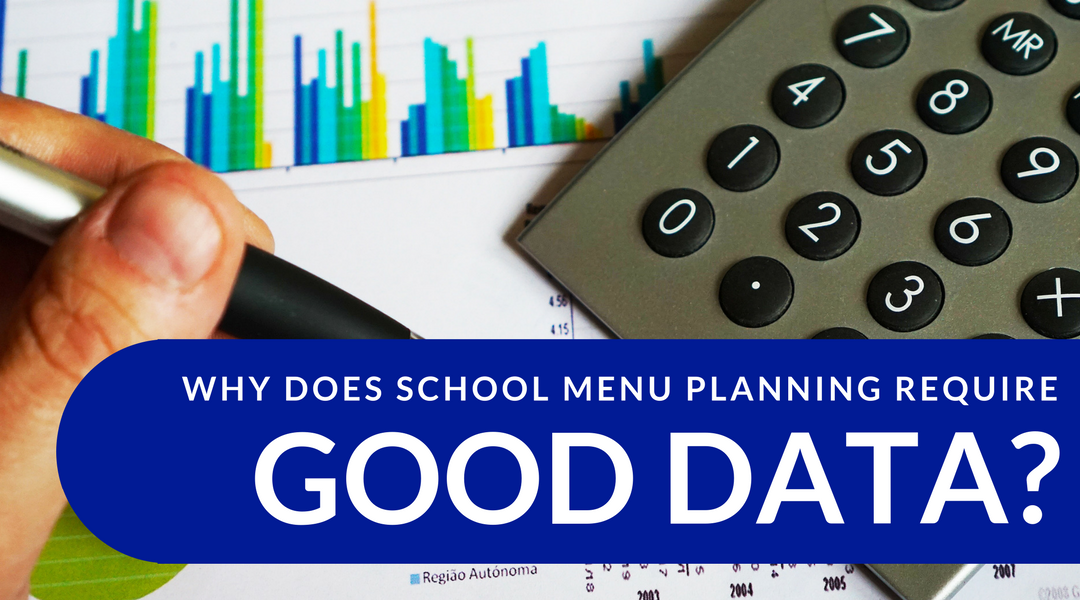When you think of school menu planning, you think of food: pizza, chicken fingers, vegetables, salads. How often do you think of data when you think of school menu planning? Probably not as much.
Data is absolutely vital to running a strong, seamless foodservice operation in schools. From school menu planning to purchasing and budgeting, the more accurate the data you have, the better your decisions will be. If you have an accurate count of the food in inventory, you can order the correct amount so you neither have too much nor too little. Ensuring you have the right amount of food enables you to stick within the budget and prevents unnecessary stress and wasted time.
In a recent Harvard Business Review article, we learn that “[m]ost managers know, anecdotally at least, that poor quality data is troublesome. Bad data wastes time, increases costs, weakens decision making, angers customers, and makes it more difficult to execute any sort of data strategy. Indeed, data has a credibility problem.”
It’s one thing to have data, and it’s another thing to have good data. How can you make sure you have good data for school menu planning, the kind of data that empowers you and your staff to make the best choices–both for students and for the bottom line–while saving you time?
At Health-e Pro, good data starts with the ingredients. When we work with school districts using Health-e Meal Planner, we start at the most foundational level: making sure each ingredient is accurate and has proper documentation. When the data is accurate at the ingredient level, building recipes and cycle menus from there becomes exponentially easier. With bad data at the ingredient level, everything else would be messed up. For example, having the wrong serving size or yield could throw off the nutrients in either the ingredient or recipe and cause carbs or sugar to be off, which is problematic for those closely monitoring carb count.
The HBR article shared a similar concept: “While some data quality issues are unfathomably complex, …Eliminating a single root cause can prevent thousands of future errors, save [significantly], and make things better for all involved.”
The importance of good data at the ingredient level cannot be overstated. If the data is bad in the production numbers, that can skew ordering with a popular item seem as unpopular, or vice versa. Bad data in production means food directors don’t know exactly what students are eating or not eating. Directors want to serve a menu that students will love, but with bad data, how will they know? Good data combined with good software makes a powerful combination that empowers schools to make school lunch better.
Even if you don’t care about data per se, you still must do your work effectively and efficiently. Bad data is a lens into bad work, and our results provide powerful evidence that most data is bad. Unless you have strong evidence to the contrary, managers must conclude that bad data is adversely affecting their work. HBR
Cleaning up data can be a tedious process, but a necessary one. When we work with customers to take their data from bad to good, we go through and edit or deactivate ingredients or recipes that are inaccurate. We also review the current menu and check ingredients and recipes, making sure the spec sheets and CN labels are attached, that allergen information is present and that service size and meal components are accurate. Essentially, cleaning up data means making it accurate and compliant.
What’s the end result of good data on school menu planning? Good data makes the overall nutrition of the students better. Also, the students enjoy what they are eating and the director is compliant. Additionally, good data creates a lot of trust between the parents and the school because the child’s nutritional and allergen needs are being handled and the child is eating well. Within Health-e Pro’s software, there are plenty of reports available to directors to help maintain compliance and that help run production smoothly.
Another important component of good data within school menu planning and nutrient analysis is the accessibility of spec sheets. In a blog post written by our founder, Meg Chesley, she discussed the importance of creating software that made access to spec sheets “simple and easy since the software acts as a repository for all ingredient and recipe information”:
There was no distribution or sharing mechanism that would allow districts to have access to the most current spec sheets. Most manufacturers distributed them infrequently and very little was available online, if at all. Over and over again, the same products were used by my various customers. I recreated the same information repeatedly, requiring elaborate tracking systems for each district. Keeping it all straight for multiple districts took more time than the actual data entry. There was just no easy way to do it and it was just frustratingly time consuming.
Another recent blog post detailed the importance of current recipes with current nutritional information: “I see schools submitting 5-year-old USDA recipes that used to meet the grain requirements when they were based off of the enriched amounts. With whole grains now being required, ingredient weights for grains need to be reviewed and adjusted to ensure they are still providing the same amount of ounce equivalents stated.”
Again, the importance of good data cannot be overstated. Accurate data, makes school menu planning easier, improves the student’s nutrition, and eases any concerns parents or other administrators may have relating to allergens or overall nutrition. Ensuring your data is accurate is the most important step in moving your nutrition program forward.

